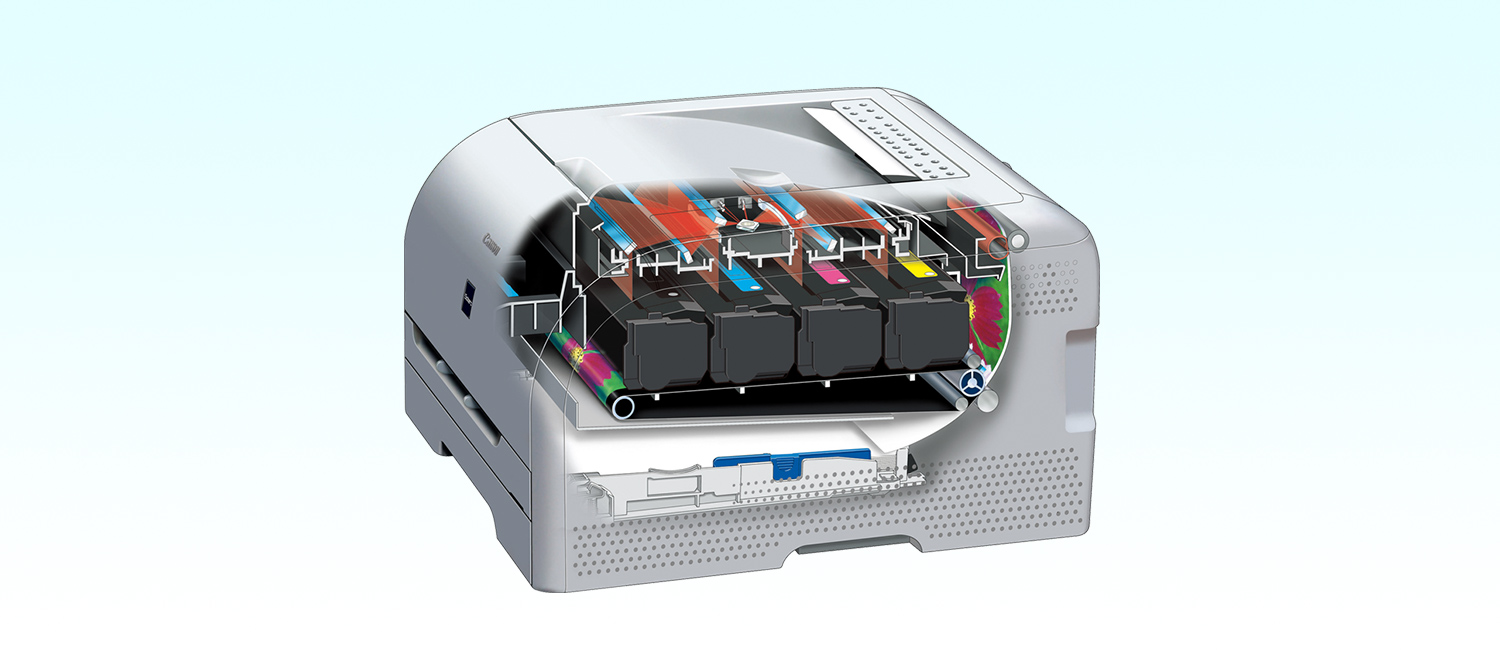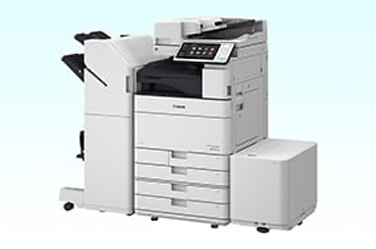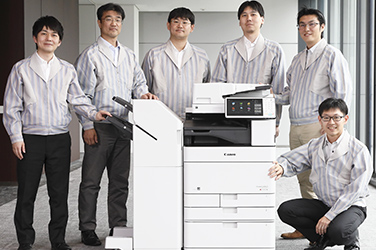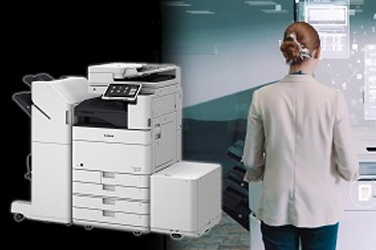Technology in ProductsLaser Printers and MFPs
Convenient printing and
greater environmentally friendliness
Laser printers process data such as documents and materials created on a PC and output them on paper. Multifunction laser printers (MFPs) are laser printers equipped with additional functions such as copying, scanning, and faxing. Laser printers and MFPs are used not only in offices but also in schools, hospitals, and various other settings because they are easy to maintain and can be linked to a wireless LAN or mobile devices.
July 28, 2022

How laser printers work
Laser printers are printers that use electrophotographic technology. First, data sent from a PC is converted into printing data by a print engine. The print command is converted into laser light, which is irradiated (exposed) onto a cylindrical photosensitive drum. The photosensitive drum is charged with static electricity beforehand, and the exposure causes the static electricity to dissipate only in the printed area (development). When the photosensitive drum is covered with powdered ink toner, the toner remains only in the area exposed to the laser beam, and the force of static electricity attracts (transfers) the toner onto the paper. Heat and pressure are applied to adhere (fix) the toner onto the paper, and printing is complete.
A laser printer gets its name because it uses laser light for exposure, and its mechanism consists of two main parts: a laser scanner and a printer.
Read More
Laser printer and MFP technologies
Canon offers laser printers and MFPs that provide beautiful printing at high speeds, thanks to their electrophotographic and laser technologies, which Canon has cultivated throughout the history of its photocopier business. Canon is also a leader in the development of environmentally friendly technologies, such as systems that recycle used cartridges instead of simply disposing of them, and technologies that reduce standby power consumption of printers.
Configuration-free architecture
Canon has created a lightweight and compact R&D architecture that allows flexible combinations of devices, controls, and functions to enable low-cost, rapid development of a wide variety of products, from single-function printers to MFPs.
Using this architecture, “devices” such as scanners and printers, “controls” such as UIs, and “functions” such as copying, printing, and scanning can be provided as modular blocks and freely combined to create products. Blocks of devices and functions are easily allocated, contributing to more efficient development and higher quality. New functions, such as mobile printing and authentication, can be added as desired, demonstrating the architecture’s capacity to realize higher performance. In addition, language-dependent portions are completely separate, enabling simultaneous commercial roll-out in more than 30 languages.

Conceptual Diagram of the Free Configuration Architecture
Unique energy-saving technology
Canon is using its unique energy-saving technologies to reduce the power consumption of laser printers and MFPs. One such technology is Canon's unique On-demand Fixing Technology. In laser printers and MFPs, powdered toner is melted by a heat source and put under pressure by a pressure roller, fixing it onto paper. Conventional fixing technology that was widely used in the past heated the fixing roller with heat transmitted from a halogen heater installed inside the roller. With this method, the fixing roller heats up slowly, so printing cannot start right away, and the fixing roller has to be kept warm while the printer is on standby.

On-demand fixing system
Canon focused on the issue of fixing early in the R&D process, developing an on-demand fixing unit consisting of fixing film with a low thermal capacity and a ceramic heater that directly heats the fixing film. The heater does not need to be kept warm in standby mode. Instead, it is activated upon receipt of a print command to instantly provide heat, thereby reducing the time required to begin printing starts from several minutes to several seconds. The system provides a high-speed FPOT (first print out time, or the time it takes for the first sheet of media to be output). At the same time, it also significantly reduces energy consumption in standby mode by heating the heater only when printing. This revolutionary technology remains a feature of Canon’s laser printers today.
Moreover, Canon’s unique IH Fixing Technology, which instantly heats the fixing roller, uses the principle of induction heating, which is used in such devices as home rice cookers. This technology allows sufficient heat to be generated in a short amount of time. Canon remains committed to meeting demand for more environmentally friendly operations by reducing its CO2 emissions.
A 4-in-1 ultra-slim laser scanner facilitates a smaller device size
Conventional laser scanners contained four separate laser scanners that scanned four separate laser drums, corresponding to the four CMYK colors, to etch an image onto a photosensitive drum. Meanwhile, “4-in-1 Ultra-slim Laser Scanner” technology directs laser beams for the four colors diagonally towards a single polygonal mirror, splitting the optical path into four directions and reflecting the beams back through the mirror to each photosensitive drum. The polygonal mirror is positioned low in the center of the scanner body, and the optical path of the laser is carefully designed. This makes possible smaller and slimmer laser printers and MFPs.

4-in-1 ultra-slim laser scanner
Integrated toner cartridges


In 1982, Canon developed the world’s first integrated toner cartridge system, in which the toner, photosensitive drum, and other major components are replaced together. This system eliminated the need for regular maintenance of printers, and the easy maintenance, compact size, and high quality of laser printers made them a massive hit and led to their use around the world.
Canon developed its proprietary “polymerized S toner,” a spherical ultrafine particle toner with a microcapsule structure, for color printing. This toner can encapsulate a large amount of wax, which serves as a substitute for fixing oil, inside the toner. This results in more natural and higher image quality with no glare or graininess.
Recycling toner cartridges to reuse resources

Closed-loop recycling of toner cartridges
Canon pioneered the “Toner Cartridge Recycling Program” in 1990, ahead of other companies, with the goals of using resources effectively and reducing waste. Canon has five recycling sites around the world where used toner cartridges are collected and the plastic material is reused as material for new toner cartridges through a process known as “closed-loop recycling.”






